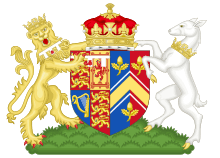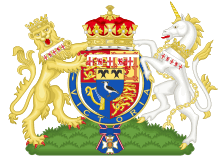Women in heraldry

Due to the differing role of women in past society, special rules grew relating to the blazoning of arms for women. In both the English[1] and the Scottish[2] systems of heraldry these differences remain active. In other nations, in Canadian heraldry for example, women may inherit arms on an equal basis with their brothers (if any). Women in Canada may also transmit their arms to their heirs, regardless of gender. This system of equality for men and women is a result of provisions in the Canadian Charter of Rights and Freedoms, which guarantee, among other things, freedom from discrimination under the law on the basis of sex.[3]
British Heraldry
.svg.png)
In English, Scottish and Northern Irish heraldry, a woman may bear arms by inheritance from her father[4] or by grant to herself. When unmarried, she displays her arms on a lozenge (a diamond shape) or on an oval or oval-like shape. Traditionally, a woman does not display her arms on a shield, as the shield originated with knights and warfare, and is thus viewed as fitting for a man, but not a woman.

When married, a woman has the option of uniting her arms with those of her husband in what are called marital arms; their arms are impaled, meaning they are placed side by side in the same shield, with those of the man on the dexter (left, as seen from the front) and those of his wife on the sinister (right, as seen from the front).[5] If one spouse belongs to the higher ranks of an order of chivalry, and is thereby entitled to surround his or her arms with a circlet of the order, it is usual to depict them on two separate shields tilted towards one another, this is termed "accollé".

A married woman may also bear either her own arms or her husband's arms alone on a shield with a small differencing mark to distinguish her from her father or husband.
Heraldic Heiresses
If the woman is an heraldic heiress, her arms are shown on an inescutcheon of pretence, which is a small shield in the centre of her husband's arms. When widowed, a woman continues to use her marital arms, but placed on a lozenge or oval. In England and Northern Ireland, if there is more than one surviving daughter, each transmits her father's arms on equal terms.[6] In Scotland however, only the eldest surviving daughter transmits her father's undifferenced arms to her offspring.[7]
Canadian Heraldry

In Canadian heraldry, women and men are treated equally for heraldic purposes, as required by Canadian equality laws.[8] It is therefore common to display the arms of women on shields, rather than on a lozenge or oval, but a woman may still choose to have her arms displayed on a traditional shape.
Cadency
In many systems of heraldry, the arms of each living person must be unique. English heraldry has used armorial variants to distinguish the arms of brothers from their father's arms and from each other since the thirteenth century;[9] this is now normally done by the system of marks or brisures set up by the early Tudor herald John Writhe.[1] Canada adds a unique series of brisures for use by female children who inherit arms. As in other heraldic systems, these cadency marks are not always used;[10] in any case, when the heir succeeds (in Canada, the first child, whether male or female, according to strict primogeniture), the mark of cadency is removed and the heir uses the plain coat of arms.[2]
- Brisures
| First | Second | Third | Fourth | Fifth | Sixth | Seventh | Eighth | Ninth | |
|---|---|---|---|---|---|---|---|---|---|
| Daughter | |
|
|
|
|
|
|
 |
|
| |
|
|
|
|
|
|
|
| |
| Son | |
|
|
.png) |
 |
|
|
 |
|
| |
|
|
|
|
|
|
|
|
See also
| Wikimedia Commons has media related to Women in heraldry. |
| Wikimedia Commons has media related to Coats of arms of women. |
References
- 1 2 "The Law of Arms: The descent of arms". College of Arms. 2004-04-10. Retrieved 2008-10-02.
- 1 2 "Beginners Heraldry, The Heraldry Society of Scotland – UK Heraldry". The Heraldry Society of Scotland. 2005-04-17. Archived from the original on 2008-10-13. Retrieved 2008-11-06.
- ↑ "Canadian Charter of Rights and Freedoms – Equality Rights". 6074332 Canada Inc., in association with SailorJones Media Inc. Retrieved 2008-11-06.
- ↑ Fox-Davies, Arthur (2007), A Complete Guide to Heraldry, Skyhorse Publishing Inc., p. 546,
Every woman is entitled to bear upon a lozenge in her own lifetime the arms, quarterings, and difference marks which belonged to her father.
- ↑ Beddoe, Alan & Galloway, Strome (1981), Beddoe's Canadian heraldry, Mika, p. 171,
If her husband is an armiger her arms leave the female lozenge and share her husband's shield, ie, are 'impaled' with his arms, his to the dexter (right) and hers to the sinister (left).
- ↑ Friar 1993, p. 181.
- ↑ Burnett 1997, p. 46.
- ↑ "Canadian Charter of Rights and Freedoms - Equality Rights". 6074332 Canada Inc., in association with SailorJones Media Inc. Retrieved June 2011. Check date values in:
|access-date=(help) - ↑ Boutell, Charles (1914). "Chapter XII". The handbook to English heraldry. Arthur Charles Fox-Davies, ed.
- 1 2 "Heraldry Examination". Royal Heraldry Society of Canada. Retrieved 2008-08-30.
